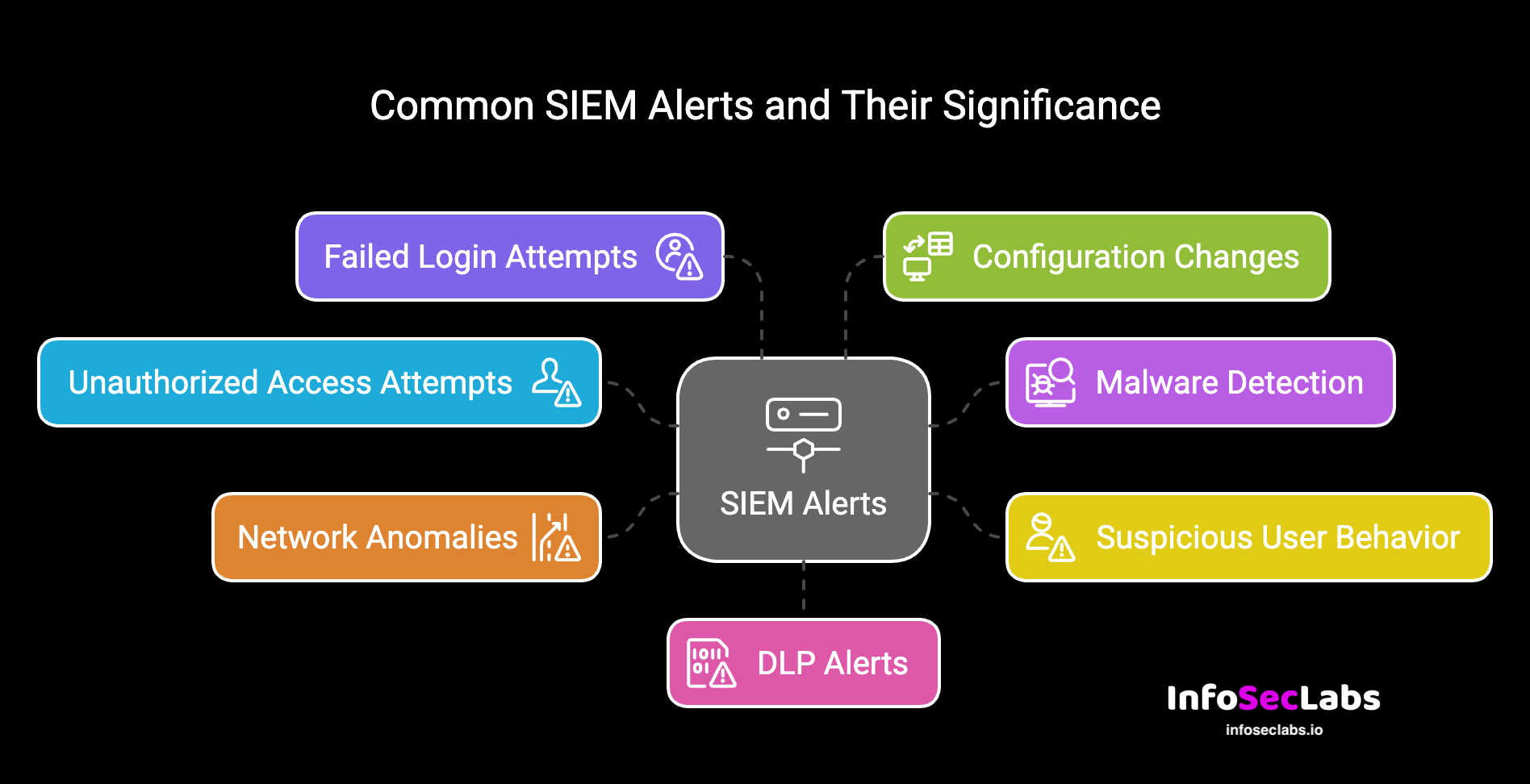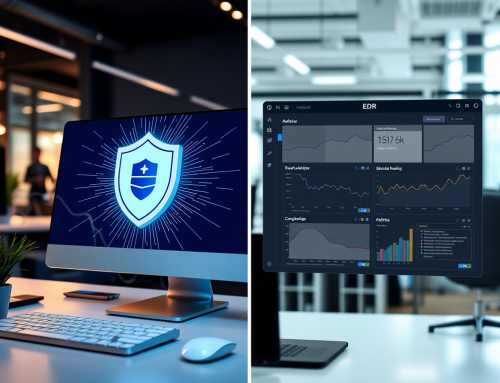Security Information and Event Management (SIEM) systems are foundational tools in modern cybersecurity. They provide critical insights into an organization’s environment by collecting, analyzing, and prioritizing data from various sources. However, one of the main challenges for security analysts and SOC (Security Operations Center) teams is managing the sheer volume of alerts generated daily.
This post dives into the most common SIEM alerts organizations encounter, including examples of critical alerts and how to prioritize, manage, and optimize your SIEM system effectively.
What Are SIEM Alerts and Why Are They Important?
SIEM alerts are notifications generated by a SIEM system when it detects activity that matches preconfigured rules or anomalies in the monitored environment. The purpose of these alerts is to help security teams address potential threats swiftly, thereby minimizing risks to the organization.
Why SIEM Alerts Matter
- Real-Time Threat Detection: Alerts identify security incidents like network intrusions or unauthorized access as they occur.
- Less Downtime: Early warning systems reduce the time to resolve critical vulnerabilities.
- Compliance: SIEM tools help organizations meet regulatory requirements by providing detailed logging and reporting.
Without proper alert management, these tools can easily overwhelm teams with noise, making it challenging to differentiate true cyber threats from false positives.
Common Types of SIEM Alerts Organizations Receive
SIEM systems can monitor a wide range of events, but certain types of alerts are more prevalent across organizations. Below are some of the categories that security analysts commonly encounter:
1. Failed Login Attempts
- Why It Happens: A user attempts to log in multiple times with incorrect credentials.
- Risk: This often indicates a brute-force attack or an insider threat attempting unauthorized access.
- Example: Multiple failed logins across different accounts within a short time frame.
2. Unusual User Behavior
- Why It Happens: A user deviates from their normal login patterns (e.g., accessing resources at odd hours).
- Risk: A compromised account or insider threat.
- Example: An employee who typically works in New York is suddenly logging in from an IP address in Eastern Europe at 3 AM.
3. Malware Detection
- Why It Happens: Malware signatures are detected on a workstation or server.
- Risk: The malware could spread laterally across networks and exfiltrate data.
- Example: A SIEM tool picks up logs from your antivirus software indicating the presence of files matching known ransomware hashes.
4. Privilege Escalation Attempts
- Why It Happens: Users or processes attempt to gain administrative privileges.
- Risk: Privilege escalation is often an early step in more complex attacks like ransomware.
- Example: A standard user suddenly tries to execute administrative commands without prior approval.
5. Data Exfiltration
- Why It Happens: Large volumes of sensitive data are transferred outside the organization’s internal network.
- Risk: A clear sign of insider threats or external breaches.
- Example: A file server sending gigabytes of data to an unknown external IP over a short duration.
6. Unauthorized Access to Critical Systems
- Why It Happens: Access attempts to systems housing sensitive data outside of permissible roles or hours.
- Risk: A sign of malicious insider activity or an attacker leveraging stolen credentials.
- Example: A user account attempts to access a database server containing financial records without prior authorization.
7. Denial-of-Service (DoS) Attack Indicators
- Why It Happens: A spike in network traffic results in a server becoming unresponsive.
- Risk: Disruption of operations, affecting customer experience and internal workflows.
- Example: Your SIEM correlates logs pointing to unusually high traffic originating from multiple IP addresses targeting a single web server.
8. Suspicious File Modifications
- Why It Happens: Critical system files are unexpectedly modified.
- Risk: Could indicate ransomware encrypting files or malware embedding payloads.
- Example: Unauthorized changes to key registry settings or .bat and .dll files.
Each of these alerts represents distinct threats that require prompt investigation and action. However, not all alerts are created equal, and some demand more immediate attention than others.
How to Effectively Manage and Prioritize SIEM Alerts
Managing SIEM alerts is like trying to sip from a firehose; you need a strategy to get the good out of it without being drowned by excessive information. Here’s how you can effectively manage and prioritize alerts:
- Categorize Alerts by Severity
-
-
- Divide alerts into categories such as critical, high, medium, and low based on the level of potential risk.
- For example, failed login attempts might be “low priority” unless they are widespread, while detected ransomware is “critical.”
-
- Correlate Multiple Alerts
-
-
- Look for patterns by correlating multiple low-priority alerts that could indicate a broader issue.
- Example: Multiple failed logins combined with privilege escalation attempts could point to a brute-force attack.
-
- Use Playbooks
-
-
- Develop automated response playbooks that guide your team on how to respond to each alert type.
-
- Leverage Threat Intelligence
-
-
- Enrich your SIEM alerts with external threat intelligence feeds to identify known malicious IP addresses, domains, or patterns.
-
- Assign Roles and Responsibilities
-
-
- Ensure your team knows who handles which types of alerts to reduce response times.
-
Best Practices for Tuning SIEM Alerts to Reduce Noise
Alert fatigue is one of the most common problems SOC teams face. The good news? Noise from unnecessary alerts can often be minimized with proper tuning and maintenance:
- Regularly Update Rules:
Ensure alerting rules are aligned with your organization’s current risks and priorities.
- Whitelist Known Activities:
Eliminate routine and expected activities (like nightly backup scripts) from generating alerts.
- Review Thresholds:
Set thresholds that reduce false positives. For instance, flag failed logins only when attempts exceed five within a minute.
- Test Alert Logic:
Conduct periodic tests to ensure that alerts are firing correctly and for the right reasons.
- Engage Stakeholders:
Regularly communicate with teams handling the SIEM to gather feedback on alert relevance.
By reducing noise, SIEM systems become more efficient for catching real threats and improving security posture.
The Role of Automation in SIEM Alert Handling
Automation is becoming an essential tool in managing the scale of enterprise alerts effectively. Here’s how it can make your life easier:
- Automated Triage:
Tools like SOAR (Security Orchestration, Automation, and Response) automate initial triage steps to sort and assign alerts by severity.
- Instant Containment:
Automation can isolate compromised systems by disabling endpoints on detecting potential breaches.
- Log Analysis at Scale:
AI-powered solutions can sift through massive logs much more effectively than manual efforts, saving time for your team.
- Faster Remediation:
Automation workflows can execute pre-approved remediation steps, like disabling compromised accounts or blocking malicious IPs.
Leveraging automation alongside effective alert tuning can greatly reduce the workload on security teams.
Fine-Tuning Your SIEM for Stronger Security
A well-optimized SIEM system is your launchpad for maintaining a robust security posture. By understanding common alerts, managing them efficiently, and leveraging automation and data tuning, SOC teams can reduce risks while ensuring streamlined operations.
Feeling overwhelmed? Tools like [Jasper] or customizable AI platforms can help your team implement many of these solutions faster.
Take the first step toward better organizational security by evaluating your current alert management strategies and optimizing your SIEM today.





